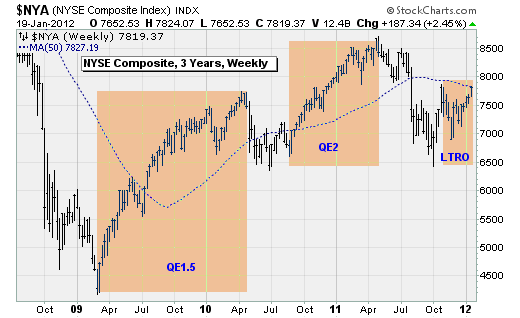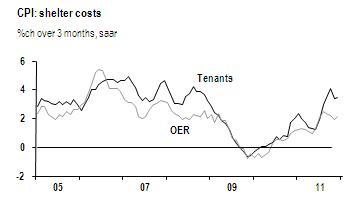The article is very important to understand the future Indian Stock market shape...Please do read....
The Euro Zone crisis could mark the end of a paradigm adopted by the East Asian ‘Tigers', and later, China.
January 25, 2012: With the Euro Zone crises showing no signs of improvement and the prospect of recession confronting various member-states, how will the rest of the globe be affected?
The most obvious way was pointed out by the recently by WB and ADB in their respective outlooks for the global economy. In its Global Economic Prospects 2012 report, the bank urged developing countries to re-evaluate their “vulnerabilities' in the light of “dimming global growth prospects and the Euro debt problem.”
With surprising alacrity, India responded by admitting ahead of the Reserve Bank of India's third-quarter monetary policy review that the next two quarters could be “difficult”. For its part, the central bank stayed with its rates intact, but reduced CRR by 50 basis points to pump in liquidity. That was, at best, a symbolic gesture, because growth is decelerating, not so much on account of liquidity, but because, well, what is one to do with all those extra funds? Cash-rich firms are staring at a bleak policy environment, a bleaker investment landscape and scouting overseas or venturing sideways into acquisitions; but that won't add to the economy's overall corpus of productive investments.
In its global outlook for 2012, the Asian Development Bank repeated its pessimistic outlook for last year, reducing expansion yet again to 7.2 per cent for the East Asian region. As the Euro debt crisis deepens, the ADB warned, export-oriented nations in ASEAN, including China, would be affected, with lesser exporting nations becoming more vulnerable.
MODEL AT A CROSSROADS
What both the WB and ADB have cautioned against is the possibility of a full-blown financial and economic crisis; both wish policymakers in the region respond “decisively and collectively” to the crisis. Already, China, for instance, has recognised its own vulnerability, and is now ruefully examining the economy's structural imbalances.
The East Asian ‘tigers' or super-exporters are no less affected by the downturn in export demand. As recession kicks in with austerity measures in select Euro Zone countries, rising protectionism may compound the problems for East Asian super-exporters, warns ADB.
At a more fundamental level, what we may now be witnessing is a crisis in a development paradigm that had acquired the character of a synodal decree in the last three decades of the twentieth century.
The export-led growth strategy, first tried out by Japan following its post-WW-II reconstruction, rode roughshod on the extant import-substitution model that populist democracies like India had touted as the most appropriate model for developing countries. Exports inspired the success story of East Asian ‘Tigers' since the 1970s.
By the 1980s, the East Asian ‘tigers' had turned the export-led strategy into an inspiration for almost every developing country, confronting cumulative economic backwardness manifest in abundant, unproductive labour and non-traded goods in South-East Asia.
The ‘Tigers' — South Korea and Taiwan in manufacturing and high-tech, and Singapore and Hong Kong as global financial hubs — inspired the ‘tiger cubs', Malaysia, the Philippines, and Thailand, though with mixed success.
But it was when China stepped out in the latter half of 1978, virtually copying the model of export-centric industrial expansion line by line, that the model received its apotheosis.
Focusing on East-Asian policymaking as a key to its phenomenal success, Robert Wade's Governing the Market, in 1992, provided the most lucid and polemical statement of export-oriented growth in South Korea and Taiwan, with the state partnering markets in a synergistic allocation of resources to maximise productivity and output.
American and European expansion helped. In the 30 years to the end of the century, the export-led strategy catapulted nations with few natural resources, cheap and abundant labour, low industrialisation and lower per capita incomes, into high-powered economies and rising trade surpluses.
The strategy had a transcendental spin-off. Nations that were, in their early industrialisation efforts, scorned for poor quality, were now crowned with the reputation for quality at the best price: first Japan, then the East Asian economies and now, with its high-tech quality exports, China.
ZERO SUM GAME
In 2003, Thomas Palley of the Open Society Institute pointed to the dangers of a ‘demonstration effect' that was turning the export-oriented strategy into a zero-sum game by “poaching of domestic demand elsewhere, or by displacing exports of some other countries.”
As he wrote, “The evidence shows that there is significant cross-country crowding out, with exports to the US from the four East Asian tiger economies (Taiwan, South Korea, Hong Kong, Singapore) being subject to a large crowding-out effect from China.”
But export displacement wasn't a problem for the US or European consumers, who were just too happy with ever-cheaper products.
During the years, and on a global scale, an imbalance was working into flash points of newer tensions. The globe was now getting crowded with more exporters than were importers, more producers than consumers.
And it really began to pinch, when September 2008 set into motion an economic crisis that brought to the surface a simmering spat between China and the US regarding the latter's policy-driven exchange rate.
With a larger number of exporters and contracting import markets, the currency tension between China and US spread wider, since every exporting country wanted to retain a price advantage. Soon after 2008, when the effects of the Wall Street meltdown began to work into a recession, the US wanted even Germany to appreciate its currency; and when exporters didn't buy its argument, the US began “quantitative easing”, driving the dollar down.
RETHINK IN CHINA
The current economic crisis and its contracting demand for imports will strike at the very heart of the model of export-oriented growth, forcing a re-evaluation of its basic premise, even as policymakers contend with falling GDP rates down the line.
More so China than East Asia: in Beijing, policymakers may have already started pondering structural imbalances intrinsic to the growth model itself.
Director, China Centre for Economic Research, Yang Yao, says that owing to cheap labour and suppressed remuneration, returns from exports have flowed mainly to capital and to the treasury by way of tax revenues. Since the share of labour incomes has been declining, so has the share of consumption in GDP. Raising domestic demand may mean an inward-oriented strategy of growth.
That may sound familiar to Indian policymakers, but then there are only so many concepts to fool around with.
http://www.thehindubusinessline.com/opinion/columns/ashoak-upadhyay/article2831736.ece?homepage=true






